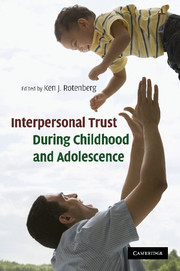Book contents
- Frontmatter
- Contents
- List of figures
- List of tables
- List of contributors
- Section I Conceptual foundations and issues
- Section II Childhood
- 5 Young children's trust in what other people say
- 6 Social relation and mutual influence analyses of children's interpersonal trust
- 7 Siblings and trust
- 8 The role of promises for children's trustworthiness and honesty
- 9 Liar liar! Pants on fire: Detecting the trustworthiness of children's statements
- Section III Adolescence and early adulthood
- Index
- References
6 - Social relation and mutual influence analyses of children's interpersonal trust
Published online by Cambridge University Press: 04 August 2010
- Frontmatter
- Contents
- List of figures
- List of tables
- List of contributors
- Section I Conceptual foundations and issues
- Section II Childhood
- 5 Young children's trust in what other people say
- 6 Social relation and mutual influence analyses of children's interpersonal trust
- 7 Siblings and trust
- 8 The role of promises for children's trustworthiness and honesty
- 9 Liar liar! Pants on fire: Detecting the trustworthiness of children's statements
- Section III Adolescence and early adulthood
- Index
- References
Summary
Interpersonal trust has been viewed as a crucial aspect of social functioning that originates in infant–caregiver interactions and affects psychosocial functioning across the life-span (Armsden and Greenberg, 1987; Erikson, 1963; Waters, Vaughn, Posada, and Kondo-Ikemura, 1995). Researchers have found that children's interpersonal trust is associated with various aspects of their psychosocial functioning. Specifically, trustworthiness in children has been found to be associated with, and longitudinally predictive of, the number of their friendships (Rotenberg, McDougall, Boulton, Vaillancourt, Fox, and Hymel, 2004) and their adjustment to school (Betts and Rotenberg, 2007; Betts, Rotenberg, and Trueman, 2009; Rotenberg, Michalik, Eisenberg, and Betts, 2008). Children's trust beliefs have been found to be associated with honesty (Wright and Kirmani, 1977), lack of depression (Lester and Gatto, 1990), academic achievement (Imber, 1973), and lack of loneliness (Rotenberg, MacDonald, and King, 2004). Rotenberg, Boulton, and Fox (2005) found that the trust beliefs of elementary school children were negatively associated with, and longitudinally predictive of, internalized maladjustment (loneliness, depression, and anxiety). Also, a curvilinear relationship was found whereby children with very high and those with very low trust beliefs were at additional risk for internalized maladjustment. Some researchers (see Chapter 2) have highlighted that interpersonal trust during childhood is dyadic and reciprocal in nature, but there is a scarcity of research addressing this hypothesis.
- Type
- Chapter
- Information
- Interpersonal Trust during Childhood and Adolescence , pp. 110 - 132Publisher: Cambridge University PressPrint publication year: 2010
References
- 4
- Cited by



